The island of Bermuda is a great draw for sun lovers because it flaunts some of the best beaches in the world. Situated at the northwest part of the Atlantic Ocean about 580 miles (933.42 km) from Cape Hatteras, North Carolina is the island of Bermuda, which is also popularly known as the “Bermuda Triangle”. The triangle has always been and still continues to be a sphere of interest for many all over the world. Luckily, though, we offer 5 Reasons Why the Bermuda Triangle is Fake. The mystery definitely contributed to Bermuda being known as the shipwreck capital of the world, but it isn’t because of a mysterious triangle, when you dive in Bermuda, you’ll soon see that there are countless coral reefs and ledges that rise close enough to the surface to sink the largest of ships. Many sunken ships can be seen by divers, some of which are pretty close to the shore and within reach by dive boats in shallow waters.
When you dive Bermuda’s best shipwrecks, you can take a certificate home as a memento. If the certificate is available for a particular shipwreck below, click the link under the shipwreck that says, “Click to Download”. You can download the certificate for free and print it yourself and bring it to the dive shop for a signature from your Dive Master and Operator. Most shops sell these certificates, but if you really want one, take advantage and download them for free below.
Before discussing the shipwrecks below, always remember that it is dangerous to dive alone. Always have your dive buddy near you, and we recommend you take advantage of our private charters, some of which offer scuba diving, or any of the commercial operators that head out to Bermuda’s coral reef and shipwrecks daily.
Listed below are 20 shipwrecks in Bermuda which have now become popular diving spots:
- Constellation: Built in 1918, The Constellation was a four-masted wooden schooner and measured 192 feet (58.52 m) in length. She was originally named Sally Persis, but she was rebuilt and renamed The Constellation under the ownership of Mr. Robert L. Royall. The boat met her end when she was on her way to Venezuela and came across storms which caused the ship to leak through the seams. The Captain decided to stop in Bermuda to repair the ship after the crew could no longer manually pump out the incoming water. While waiting to be guided out of the unknown waters, the ship was pushed into the shallow barrier reef causing her to sink on July 30, 1942. The ship now lies at 15-25 feet underwater. Pictured below are the hundreds, if not thousands, of cement bags that were being carried on the ship before it sunk, and they became solid.
Constellation: [download id=”4833″]
- Christobal Colon: The Christobal Colon is known to be the largest shipwreck that measures 152 meters of 499 feet in length and about three decks high. The ship sank on 25th October in the year 1936 by crashing into a coral reef at the speed of 27 kilometers/ hour or 15 knots. The ship today lies about 55 feet in water and has become an anchorage for a variety of reef fishes and large groupers. The ship has a rectangular porthole which is uncommon for most wrecks and the wreckage is spread out about 100,000 square feet of the sea floor which offers ceaseless hours of exploration to the divers.
Christobal Colon: [download id=”4831″]
- Hermes: Built in 1943, the Hermes was a small ship of only 165 feet in length. It is perhaps one of the most popular wrecks since its watery grave is located in amazingly clear water sitting in the pink and white sand reflecting sunlight 80 feet below. The shipwreck is also surrounded by deep coral reef. The Hermes was on her way to Cape Verde Island when she started having engine troubles, but she was abandoned in Bermuda because the repair cost was too expensive. The ship was put up for sale but did not attract any interest. The ship was therefore made safe and approved to be part of an artificial reef. She was scuttled on May 15, 1985. The wreck now sits perfectly intact 80 feet underwater. On a clear day, you will jump off the back of the dive boat, and see the ship right below you. It is an amazing site.
Hermes: [download id=”4838″]
- Iristo: One of the most unlucky shipwrecks that took place in the year 1937 due to another shipwreck. The captain of the ship was not familiar with the Bermuda reefs and stunned by the sight of the Cristobal colon decided to turn his ship away and crashed into a submerged reef. The Aristo measured 250 foot and carried a cargo loaded with free engine, steamrollers and drums. It now lays 15-50 feet in water.
Iristo: [download id=”4827″]
- Lartington: The Lartington, an early vintage cargo ship, made Bermuda its watery grave when she ran into storms and a rough sea. Her hull got cracked when a giant wave crashed in and consequently caused an uncontrollable influx of water impossible to reverse. She was on her way to Russia with a cargo of cotton and had to veer off to Bermuda when the ship’s hull cracked. She sank on December 14, 1879 and much of the ship has been scattered away on the seabed at 15-30 feet underwater. The hull, steamer and propellers are still visible. The freighter now houses various seawater species such as lobsters, urchins and French Grunts.
Lartington: [download id=”4836″]
- L’Herminie: L’Herminie, measuring 300 feet in length, was a French warship vessel equipped with 60 cannons. She was on her way to the Mexican waters and had reached Havana when a number of the crew members came down with yellow fellow. She was ordered back to France since the crew members were helplessly sick when the ship came across rough seas. While trying to seek shelter on the island of Bermuda, she inadvertently hit the reefs. The French frigate sank in 1838, and she now lies at 35 feet underwater. Parts of the ship are still visible, including the cannons even though the wooden hull is mostly gone.
L’Herminie: [download id=”4840″]
- Mary Celestia: Known as the most historic shipwrecks in Bermuda is the Mary Celestia which was a side paddle-wheel steamer commissioned by the federation during the Civil war in America. It was used as a barricade runner that smuggled guns, food, and ammunition to the southern troops. The ship measures 68 meters and sank in the year 1864 by hitting a coral reef at the southern shore of Bermuda. The wreck is about 55 meters in water with one of the paddle-wheels standing vertical like a mini Ferris wheel, the other wheel, on the other hand, lies flat in the sand.
Mary Celestia: [download id=”4842″]
- Minnie Breslauer: Known to be the most unfortunate ships to sink in Bermuda. The 300-foot ship was en route between Portugal and New York carrying cargo with wine, dried fruit, bales of cork and lead ingots of 160 pounds. The ship was heading towards the shore when it crashed into one of Bermuda’s treacherous coral reefs. The ship sank due to the attempt of backing it off from the reef. It now lays 35-70 feet in water.
Minnie Breslauer: [download id=”4844″]
- Montana (Nola): This is the shipwreck in the image at the very top of this article. What is shown in the image is one of the ship’s boilers. The top of the boiler reaches around 5 feet beneath the surface. The paddle wheel steamer was a 236-foot civil war blockade runner. The ship was known under various names including Montana, Nola, Gloria, and Paramount. In December 1863, the successful steamer plowed right into the coral reefs and met with her unfortunate fate when she was trying to get away from the threatening weather conditions. The wreck now sits at 30 feet underwater and after nearly 150 years, the ship has collapsed on itself with few parts of the ship intact. The paddle wheels resemble small Ferris wheels, which provide structure for the coral reef and reef fish.
Montana (Nola): [download id=”4847″]
- North Carolina: The unfortunate ship sank on New Year’s Day in the year 1880, when she hit the reef, while it was in transit from Bermuda to England with a cargo loaded with fuel, bark, and cotton. The ship measured 205 feet (62.48 m) long and displaced 533 tons. It now lies about 20-45 feet in water with her mid-section collapsed, while the bow and stern are pretty intact still.
North Carolina: [download id=”4857″]
- Taunton: The Danish steamer was carrying a load of coal when the ship encountered a fog on the way to St George. Despite the Captain’s posting of a lookout, the ship still bottomed on Bermuda’s perilous reefs. The shipwreck location is a favorite location with divers, and the shipwreck is actually quite captivating with the bright tropical fish. The wreck now lies at 10-40 feet underwater with the bow, steam, and boilers still visible.
Taunton: [download id=”4864″]
- Darlington: A durable iron hurled ship that was built in the year 1881 by the Swan and Hunter shipyard in New Castle, England. The ship had a hull displacement of 1990 tons and measured 286 feet in height with a 36-foot beam. The ship sank on 22nd February 1886 when it was heading for Bremen from New Orleans, carrying a cotton and grain cargo. The captain of the ship had failed to consign a good dole out while it was navigating in unknown waters. The ship crashed in the western reefs of Bermuda and never managed to refloat again. The wreck now lies 16 feet (4.88 m) in water with the shaft, steam boilers and deck winches visible.
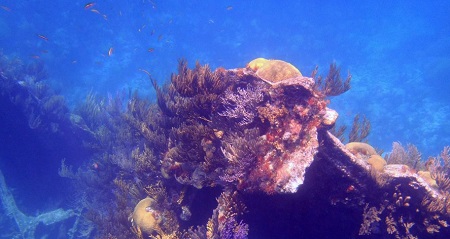
Darlington: [download id=”4849″]
- Blanche King: The wreck sank in December 1920 when she was on her way from Virginia to Bermuda carrying a load of coal. The 192 feet (58.52 m) ship with a retractable centerboard which allowed navigation in shallow waters crashed into the coral reefs and sank. It now lies in 35 feet (10.67 m) of water near North Carolina.
Blanche King: [download id=”4851″]
- Caraquet: The ship wrecked in the summer of 1923 while it was travelling from St. John, BVI to Halifax when the ship crashed into the northwest corner of Bermuda. Poor visibility, strong wind currents and rough seas pushed the ship and made it impossible to find land sightings. The wreck now lies in 30 feet (9.14 m) of water.
Caraquet: [download id=”4853″]
- Madiana: Another ill-fated ship that was travelling from New York to West Indies planned a stop in Bermuda and sank on 10th February 1903 while circumnavigating channels to Hamilton Harbor. The ship now lies at 25-30 feet in waters at the Southwest of North Rock.
Madiana: [download id=”4855″]
- Xing Da: The Xing Da, which literally means “lucky ride” ran out of luck when the modern pirate ship ran into the US coast guards at a rendezvous point made with a smaller ship to transfer the human cargo. The Xing Da was carrying illegal immigrants to be smuggled into the United States, and the ship was run by members of the Chinese Triad. Once the ship was possessed by the US government, it was taken apart when the Bermudian government asked for possession of the ship. On May 15, 1997, the ship was towed to its watery grave past the northwest barrier reef. She was purposefully sunk and now rests in 104 feet (31.7 m) underwater.
Xing Da: [download id=”4860″]
- Pelinaion: The Pelinaion was bound to Baltimore from West Africa with a cargo of iron ore when she struck against the reef of St David’s Head. The ill-fated majestic ship was 385 foot long with a 50-foot beam. She struck the reefs and sank on January 14th, 1940 after the British had blacked out the lighthouse to avoid the Germans from spying on Bermuda. The hit split the cargo steamer into two; the bow now sits at 30 feet (9.14 m) underwater, while the stern lies in 70 feet (21.34 m) of water. The sight is enthralling because of the massive size of the ship. She now houses grunts and snappers, and barracudas can often be spotted around the wreck.
Pelinaion: [download id=”4862″]
- Rita Zovetta: The Rita Zovetta, an Italian cargo ship, met with her unfortunate end in 1924 when the boat was ran aground by the strong winds which veered her into the reefs of St David’s Island. The ship, which was carrying manganese ore, was bound to Baltimore, Maryland when it ran into the coast. The boat now lies at 20-70 feet of water. The shipwreck is a favorite with divers and underwater photographers due to the colorful fish that now live within the ship which is relatively still intact with the boilers and propellers still visible.
- King George: King George, unlike many other shipwrecks, was deliberately sunken in 1930. Initially built with 30 buckets which could dig down to 30 feet (9.14 m), the dredging boat became obsolete and was found to be redundant in the face of modern transportation. The ship was then taken 5 miles (8.05 km) inside of North Rock where it was gently let down into the ocean. The ship, which is nearly still perfectly intact, now lies at 60 feet (18.29 m) underwater.
- The Kate: The Kate, with a load of cotton, was en route to France when she smashed against the reefs some miles in the northwest of the Gibbs Hill Lighthouse on November 30, 1878. Since the ship was too damaged to be towed, she had to be grounded for the cargo to be saved. Crew and cargo were both saved. However, the ship was pushed into deeper waters at 45 feet (13.72 m) by a strong gale. She is now located in a fishing site and parts of the ship are still intact, with the propeller visible on the reefs.
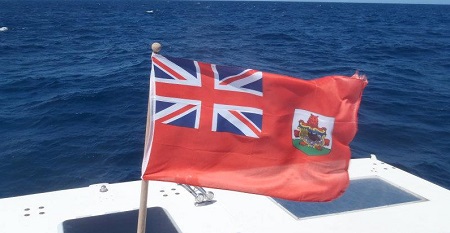

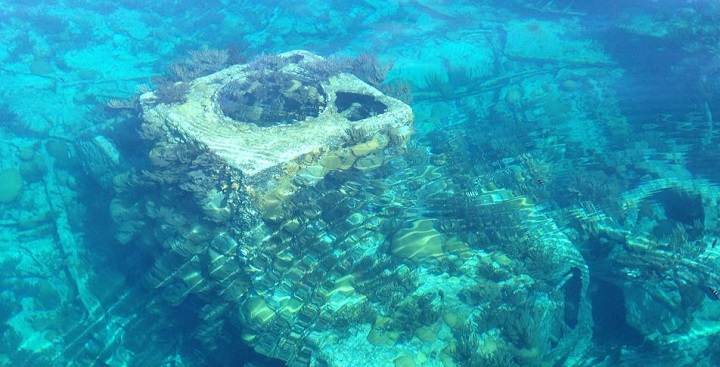
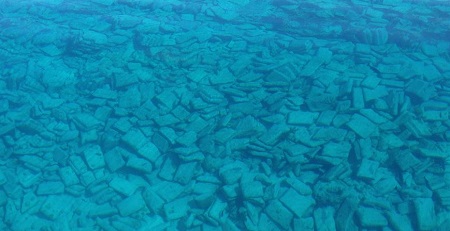
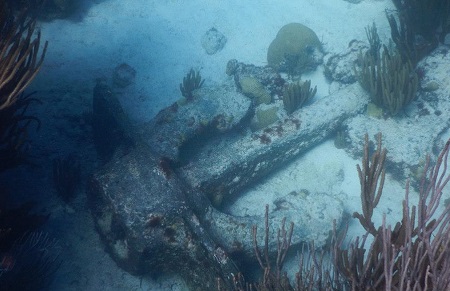
Can’t we send a computerized ship to track what is going on in Bermuda Triangle.
Hey George, you may be interested in our article here that explains why the Bermuda Triangle is a myth. Have a read, I think it makes some great points: https://thinkingofbermuda.com/is-the-bermuda-triangle-real/